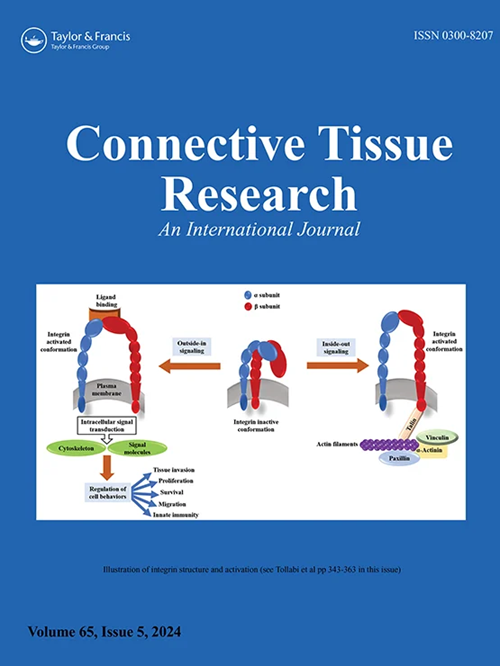人脐带间充质干细胞的细胞外小泡通过介导miR-29b-3p/PPTEN减少脂多糖诱导的脊髓损伤神经元凋亡
IF 2.8
4区 医学
Q3 CELL BIOLOGY
引用次数: 6
摘要
摘要目的本研究探讨hUC-MSCs-EVs是否通过miR-29b-3p抑制PTEN表达并激活PI3K/AKT通路,从而抑制LPS诱导的神经元损伤的分子机制。方法对hUC间充质干细胞进行培养和鉴定。观察细胞形态。茜素红、油红O和阿新蓝染色用于诱导成骨、脂肪生成和软骨生成。从hUC间充质干细胞中提取EVs,并通过透射电镜观察和蛋白质印迹进行鉴定。采用24小时脂多糖(LPS)诱导建立SCI神经元模型。在未经任何处理的EVs培养细胞后,通过免疫荧光标记、RT-qPCR、MTT、流式细胞术检测SCI神经元对EVs的摄取、miR-29b-3p表达、细胞活力、凋亡、胱天蛋白酶-3、裂解的胱天蛋白酶3、胱天酶9、Bcl-2、PTEN、PI3K、AKT和p-AKT蛋白水平、胱天蛋白3和胱天蛋白酶9活性以及炎症因子IL-6和IL-1β水平,蛋白质印迹、胱天蛋白酶3和胱天蛋白酶9活性检测试剂盒和ELISA。PTEN和miR-29b-3p之间的结合位点通过数据库进行预测,并通过双荧光素酶测定进行验证。结果成功建立了LPS诱导的脊髓损伤细胞模型,hUC-MSCs-EVs可抑制LPS诱导的损伤脊髓神经元凋亡。EVs将miR-29b-3p转移到LPS诱导的损伤神经元中。miR-29b-3p沉默逆转了EV减少LPS诱导的神经元凋亡的作用。miR-29b-3p通过靶向PTEN减少LPS诱导的神经元凋亡。EVs-miR-inhibi和si-PPTEN治疗后,PI3K/AKT通路的抑制逆转了hUC-MSCs-EVs减少LPS诱导的神经元凋亡的作用。结论hUC-MSCs-EVs通过携带miR-29b-3p进入SCI神经元并沉默PTEN来激活PI3K/AKT通路,从而减少神经元凋亡。本文章由计算机程序翻译,如有差异,请以英文原文为准。
Extracellular vesicles from human umbilical cord mesenchymal stem cells reduce lipopolysaccharide-induced spinal cord injury neuronal apoptosis by mediating miR-29b-3p/PTEN
ABSTRACT Objective This study investigated the molecular mechanism of whether hUC-MSCs-EVs repressed PTEN expression and activated the PI3K/AKT pathway through miR-29b-3p, thus inhibiting LPS-induced neuronal injury. Methods hUC-MSCs were cultured and then identified. Cell morphology was observed. Alizarin red, oil red O, and alcian blue staining were used for inducing osteogenesis, adipogenesis, and chondrogenesis. EVs were extracted from hUC-MSCs and identified by transmission electron microscope observation and Western blot. SCI neuron model was established by 24h lipopolysaccharide (LPS) induction. After the cells were cultured with EVs without any treatment, uptake of EVs by SCI neurons, miR-29b-3p expression, cell viability, apoptosis, caspase-3, cleaved caspase-3, caspase 9, Bcl-2, PTEN, PI3K, AKT, and p-Akt protein levels, caspase 3 and caspase 9 activities, and inflammatory factors IL-6 and IL-1β levels were detected by immunofluorescence labeling, RT-qPCR, MTT, flow cytometry, Western blot, caspase 3 and caspase 9 activity detection kits, and ELISA. The binding sites between PTEN and miR-29b-3p were predicted by the database and verified by dual-luciferase assay. Results LPS-induced SCI cell model was successfully established, and hUC-MSCs-EVs inhibited LPS-induced apoptosis of injured spinal cord neurons. EVs transferred miR-29b-3p into LPS-induced injured neurons. miR-29b-3p silencing reversed EV effects on reducing LPS-induced neuronal apoptosis. miR-29b-3p reduced LPS-induced neuronal apoptosis by targeting PTEN. After EVs-miR-inhi and si-PTEN treatment, inhibition of the PI3K/AKT pathway reversed hUC-MSCs-EVs effects on reducing LPS-induced neuronal apoptosis. Conclusion hUC-MSCs-EVs activated the PI3K/AKT pathway by carrying miR-29b-3p into SCI neurons and silencing PTEN, thus reducing neuronal apoptosis.
求助全文
通过发布文献求助,成功后即可免费获取论文全文。
去求助
来源期刊

Connective Tissue Research
生物-细胞生物学
CiteScore
6.60
自引率
3.40%
发文量
37
审稿时长
2 months
期刊介绍:
The aim of Connective Tissue Research is to present original and significant research in all basic areas of connective tissue and matrix biology.
The journal also provides topical reviews and, on occasion, the proceedings of conferences in areas of special interest at which original work is presented.
The journal supports an interdisciplinary approach; we present a variety of perspectives from different disciplines, including
Biochemistry
Cell and Molecular Biology
Immunology
Structural Biology
Biophysics
Biomechanics
Regenerative Medicine
The interests of the Editorial Board are to understand, mechanistically, the structure-function relationships in connective tissue extracellular matrix, and its associated cells, through interpretation of sophisticated experimentation using state-of-the-art technologies that include molecular genetics, imaging, immunology, biomechanics and tissue engineering.
 求助内容:
求助内容: 应助结果提醒方式:
应助结果提醒方式:


